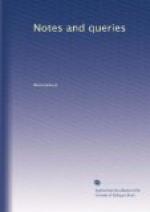“My servant Massinger hathe besought me to ayde him in obteyning a reversion from her Majestie of the Examiner’s office in this courte; whereunto, as I willingly have yielded, soe I resolved to leave the craving of your Lordship’s furtheraunce to his owne humble sute; but because I heare a sonn of Mr. Fox (her Majestie’s Secretary here) doth make sute for the same, and for the Mr. Sherar, who now enjoyethe it, is sicklie, I am boulde to desier your Lordship’s honorable favour to my servaunte, which I shall most kindlie accepte, and he for the same ever rest bounde to praye for your Lordship. And thus, leaving further to trouble you, &c. 28. March, 1587. H. PEMBROKE.”
The whole body of this communication, it is worth remark, is in the handwriting of Arthur Massinger (whose penmanship was not unlike that of his son), and the signature only that of the Earl, in whose family he was entertained. I have not been able to ascertain whether the application was successful; and it is possible that some of the records of the court may exist, showing either the death of Sherar, and by whom he was succeeded about that date, or that Sherar recovered from his illness. As I have before said, it is quite clear that Arthur Massinger was high in the confidence and service of Lord Pembroke ten years after the date of the preceding note.
I have a good deal more to say about Arthur Massinger, but I must take another time for the purpose.
THE HERMIT OF HOLYPORT.
* * * * *
TOUCHSTONE’S DIAL.
(Vol. ii., p. 405.)
The conjecture of Mr. Knight, in his note to As You Like It, and to which your correspondent J.M.B. has so instructively drawn our attention, is undoubtedly correct. The “sun-ring” or ring-dial, was probably the watch of our forefathers some thousand years previous to the invention of the modern chronometer, and its history is deserving of more attention than has hitherto been paid to it. Its immense antiquity in Europe is proved by its still existing in the remotest and least civilised districts of North England, Scotland, and the Western Isles, Ireland, and in Scandinavia. I have in my possession two such rings, both of brass. The one, nearly half an inch broad, and two inches in diameter, is from the Swedish island of Gothland, and is of more modern make. It is held by the finger and thumb clasping a small brass ear or handle, to the right of which a slit in the ring extends nearly one-third of the whole length. A small narrow band of brass (about one-fifth of the width) runs along the centre of the ring, and of course covers the slit. This narrow band is movable, and has a hole in one part through which the rays of the sun can fall. On each side of the band (to the right of the handle) letters, which stand for the names of the months, are inscribed on the ring as follows:—
J A S O N D J M A M F J
[the letters in the lower row inverted]




